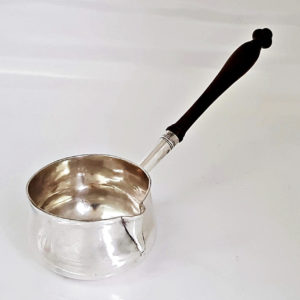John Murch
John Murch, of Exon, Devon, apprenticed to William Cory of London and Warminster in 1684. By 1694 Murch had established himself as a goldsmith in Plymouth, a wealthy, bustling and vibrant city with many silversmiths and artisans. Exeter also had many skilled silversmiths and as a result an assay office was established in Exeter in 1700. John Murch became a well-known silversmith and like many others he worked in other jobs to supplement his income. He is listed as a surveyor of Highways for St. Andrews parish in 1709. He designed and produced a variety of items, some of which are shown here and have become very collectable. Many items are now held in museums.
In 1717 John Murch departed from Plymouth and moved to Tiverton, another prosperous town to the east of Devon, with his family. He is recorded in the Exeter Goldsmiths Company Minute Book records on November 10th 1720 as entering his mark as “IM”. Murch did not always submit silver that he had worked to his local Exeter assay office for testing. Instead he adopted the standard practice of many silver makers at that time, of stamping the piece three times with his maker’s mark “IM”. It can appear at first sight that the two smaller (and sometimes indistinct) punch-marks that supplement his larger maker’s mark are formal assay marks.
John Murch
John Murch, of Exon, Devon, apprenticed to William Cory of London and Warminster in 1684. By 1694 Murch had established himself as a goldsmith in Plymouth, a wealthy, bustling and vibrant city with many silversmiths and artisans. Exeter also had many skilled silversmiths and as a result an assay office was established in Exeter in 1700. John Murch became a well-known silversmith and like many others he worked in other jobs to supplement his income. He is listed as a surveyor of Highways for St. Andrews parish in 1709. He designed and produced a variety of items, some of which are shown here and have become very collectable. Many items are now held in museums.
In 1717 John Murch departed from Plymouth and moved to Tiverton, another prosperous town to the east of Devon, with his family. He is recorded in the Exeter Goldsmiths Company Minute Book records on November 10th 1720 as entering his mark as “IM”. Murch did not always submit silver that he had worked to his local Exeter assay office for testing. Instead he adopted the standard practice of many silver makers at that time, of stamping the piece three times with his maker’s mark “IM”. It can appear at first sight that the two smaller (and sometimes indistinct) punch-marks that supplement his larger maker’s mark are formal assay marks.
-


Circa 1720
John Murch
9749 Antique Exeter Silver Brandy Pan
Sold
A rare piece of early provincial silver. An antique silver brandy warmer of bellied form with a turned wooden handle. Attractive plain style. Contains 240 ml. Total weight 153 grams, 4.9 troy ounces. Height of pan 6cm. Diameter of top 8.5cm. Spread 26cm. Exeter circa 1720. Maker John Murch.
Literature. Brandy Saucepans made their first appearance in this country during the Queen Anne period and continued to be made until the mid 19th century. Some have spouts. The size varies but generally the early examples tend to be smaller. Sometimes they have three legs, these are called skillets, and they are quite rare.